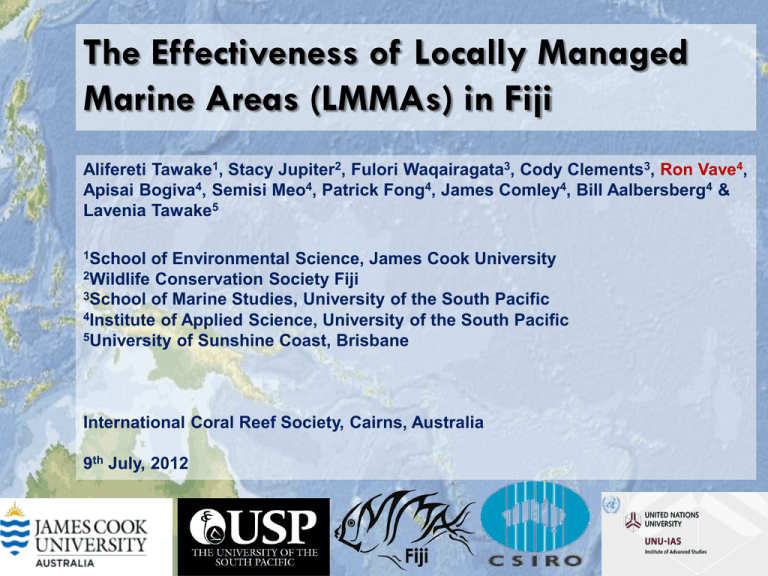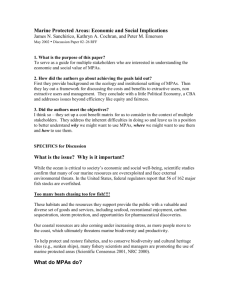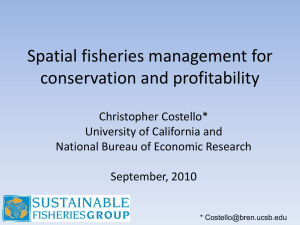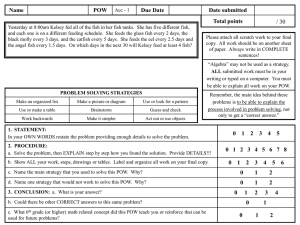12:45 Vave R - 12th International Coral Reef Symposium
advertisement

The Effectiveness of Locally Managed Marine Areas (LMMAs) in Fiji Alifereti Tawake1, Stacy Jupiter2, Fulori Waqairagata3, Cody Clements3, Ron Vave4, Apisai Bogiva4, Semisi Meo4, Patrick Fong4, James Comley4, Bill Aalbersberg4 & Lavenia Tawake5 1School of Environmental Science, James Cook University 2Wildlife Conservation Society Fiji 3School of Marine Studies, University of the South Pacific 4Institute of Applied Science, University of the South Pacific 5University of Sunshine Coast, Brisbane International Coral Reef Society, Cairns, Australia 9th July, 2012 OUTLINE OF TALK 1. 2. 3. 4. 5. 6. Concept Background: FLMMA Method of Evaluation Results Conclusion Acknowledgement CONCEPT Are Locally Managed Marine Areas (LMMAs) in Fiji achieving their intended outcomes to communities? Ecological benefits Socioeconomic benefits Background Fiji Locally Managed Marine Area (FLMMA) Network – started 1997, formalized in 2001, registered as a noncharitable organization by 2004 2012: 20 partner organizations (4 Govt, 13 NGOs & 2 Universities) 1 MPA (1997) > 386 MPAs (2012) Dual governance - government, science-based decisions - communities, traditional management practices Overfishing driven by population growth and efficient technology , made worse by climate change FLMMA works in 47% or 192 of Fijis 410 fishing grounds By 2012: 386 Tabu or MPAs (in red) 6 1 7 5 2 4 3 Method of Evaluation • LEVEL 1 (Anecdotal): Preliminary observation • LEVEL 2 (Community data) : Preliminary observations • LEVEL 3 (Rigorous scientific data): Some results • Tawake et al (JCU): 30 FLMMA sites with at least 5 years of engagement chosen & also a learning site • Stacy Jupiter (WCS-Fiji) • Cody Clements (USP Masters) • Fulori Waqairagata (USP Masters) • Assessment methods includes: •Diagnosis & content analyses of versions of mgmt plans •Scientific literature on FLMMA sites • Research uses ‘Before/After or Control/Intervention (BAI)’ design Intended Outcomes of Community Management Plans (Purpose of having MPAs) Tawake et al 2011 More fish to eat More income from fishing Restore degraded reefs and depleted species Provide opportunities to develop alternative income sources Protect fish aggregation sites Foster social and community relations Revive traditional practice, knowledge & language Theory of Change: Intended pathway to influencing communities livelihoods Tawake et al 2011 •Protection strategy – Ecosystem (Yaubula) management including LMMA strategy and tools Protecti on strategi es Safe haven Reseedi ng and spillover Healthy Qoliqoli More Fish & Catch Source of food & More income Improve d Livelihoo ds ● ● ● ● ● ● ● ● ● ● ● ● ● ● ● ● RESULTS: Improved fish abundance & biomass Significantly greater density of total fish abundance inside MPAs (Pre-harvest of Kia Island MPA) – Jupiter et al 2012 Significantly greater amount of total fish biomass inside MPAs (Kubulau & Kia Island MPAs) Significantly greater density of targeted fish abundance inside MPAs (Goetze et al, 2011) – Namena Island (Bua) Significantly greater amount of herbivorous fish inside MPAs resulting in increased grazing thus leading to reduction in macroalgae (Waqairagata et al, 2011) More herbivorous fish inside MPAs Waqairagata et al 2011 Mean Total Biomass kg/station 0.6 0.5 MPA 0.4 n=5 Fished Area 0.3 0.2 0.1 0 Acanthuridae Siganidae More herbivorous fish inside MPAs = More grazing (Improved habitat health) Waqairagata et al 2011 Improved fish catch (Mgmt plan review) Tawake et al 2011 LMMA Benefits: Any perceived change in fish catch since LMMAs were put in place? (N=30 sites, after 5-10 years) Bigger Decrease 7% n=2 Moderate Decrease 30% n=9 No change Moderate Increase 63% n=19 Bigger Increase Improved fish catch Clements 2012 Significantly greater CPUE/BPUE inside MPA Significantly greater catch diversity within intact MPAs Significantly greater proportion of fish above size reproductive maturity in MPAs Greater catch diversity within intact MPAs Clements 2012 Significantly greater catch diversity within intact MPAs More mature fish in MPAs Clements 2012 More sexually mature fish in MPAs except in Komave Size at Sexual Maturity (SSM) LMMA- Improving Household Income growth Tawake et al 2011 LMMA Benefits: Any perceived change in Household Income since the LMMA was put in place (n=30 sites) 7% n=2 sites 93% n=28 sites Decrease No change Increase Unity and Social Cohesion Tawake et al 2011 DISCUSSION: Contributing factors for Success CBAM has transformed decision making of natural resources from autocratic to participatory & democratic From chiefs to “village yaubula (natural resource) committees” Social customs that facilitate compliance within closures Exclusive & locally recognized tenure over marine resources Relatively small human populations Distance away from fishing villages Innovative selection of fish wardens = licensed fishermen NEGATIVE EVIDENCE No significant difference in total fish abundance inside MPAs (Goetze et al 2011 – Kubulau & Namuri) No significant difference in total fish biomass inside MPAs (Jupiter & Egli 2011 – some Kubulau MPAs & only in some years) DISCUSSION: Contributing factors for non-success Small size of closures Short duration of closures Non-compliance with management rules Disclosure of management success to fishers from villages with high reliance on fisheries products Conclusion The Fiji study revealed that some LMMA sites are showing improvements, both ecologically & socioeconomically, thus meeting communities needs and therefore being effective That the effectiveness of some LMMA strategies are reduced or nullified with uncontrolled opening of the MPA That preliminary scientific data validates some FLMMA communities perception of improvements. That perhaps, community monitoring data, though not highly accurate & cheap to undertake, are giving similar results to rigorous scientific studies Question is: should decision making of a communities natural resources await rigorous scientific data or can it be based on the ‘best, available community data’? Acknowledgements All FLMMA partners and sites for willingness to take part in the assessment (Tawake et al) Scientific literature (Cody Clements, Stacy Jupiter & Fulori Waqairagata) FLMMA & LMMA Network Learning group David & Lucille Packard Foundation, United Nations University (UNU), Foundation of Success, CRISP/SPREP for the partial funding support that enabled this assessment. James Cook University, USP-IAS and CSIRO for supporting PhD study (Alifereti Tawake)











